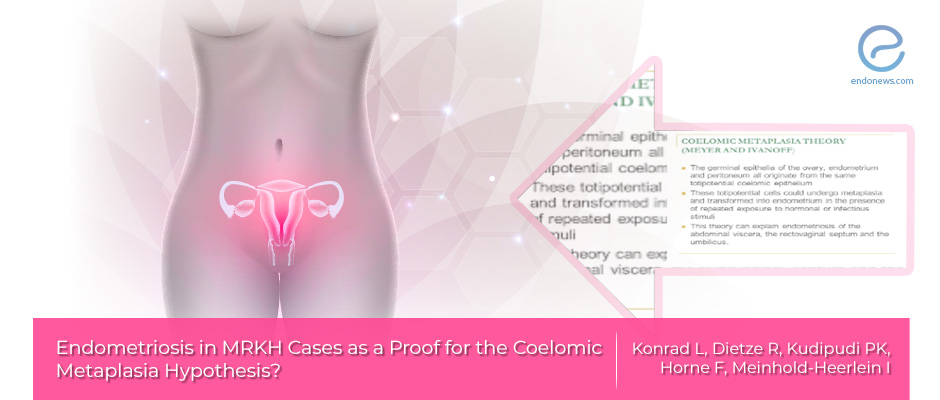The coelomic metaplasia hypothesis of endometriosis in MRKH cases
Jun 19, 2019
The development of endometriosis in patients with MRKH could be explained through implantation hypothesis from uterus/endometrium remnants and coelomic metaplasia hypothesis.
Key Points
Highlights:
- Mayer–Rokitansky–Küster–Hauser (MRKH) syndrome is a disease supporting both implantation hypothesis of Sampson and the coelomic metaplasia hypothesis, in the endometriosis development.
Importance:
- The pathophysiological mechanism of endometriosis has been tried to be explained by several theories including the coelomic metaplasia hypothesis.
What’s done here?
- This study was based on a search using Medline with the keywords ‘Mayer-Rokitansky-Kuster-Hauser’ or ‘MRK’ in combination with ‘uterus’, ‘endometrium’ ‘endometriosis’, ‘adenomyosis’, ‘metaplasia’.
- 21 manuscripts were identified evaluating the coexistence of MRKH and endometriosis.
- The diagnosis of MRKH was achieved by magnetic resonance imaging (MRI) and/or ultrasound.
- Endometriosis, especially ovarian endometriosis and adenomyosis were also diagnosed in this population.
- The pathophysiological mechanism for the development of endometriosis was evaluated in cases where a biopsy can be performed.
- The histological analysis of the uterus, eutopic and ectopic endometrium were evaluated.
Key results:
- A total of 21 manuscripts, 19 of which were case reports, who met the criteria for the search were included in that study.
- MRI was accepted as the diagnostic modality of all uterine anomalies, including MRKH.
- MRKH syndrome is characterized by congenital aplasia of the vagina, cervix, and uterus. Its incidence is estimated to be 1/ 4000-5000 female newborns with a normal karyotype and ovarian function.
- Uterine remnants were detected with MRI to be compatible with laparoscopy at 77.3% in MRKH cases.
- MRI was demonstrated not to be sufficient for the detection of uterine remnants. Ultrasound was shown to have even lower sensitivity for this purpose.
- Endometrium was demonstrated on the histological analysis of the biopsies from uterine remnants in approximately 40.5%.
- Endometriosis was proven in MRKH patients without the presence of uterus/endometrium and metaplasia was suggested as the underlying cause for the development of endometriosis in these women. However, the hypothesis of how metaplasia develops has not been explained by any author.
Lay Summary
Endometriosis is defined as the localization of endometrial glandular and stromal tissue outside the uterine cavity and its incidence is approximately 10% in the general female population. Although the pathophysiological mechanism is not clearly understood, the implantation theory by Sampson is the most accepted hypothesis.
According to the Sampson theory, endometriotic lesions develop from the endometrial cells spreading into the peritoneal cavity through Fallopian tubes during menstruation. However, retrograde menstruation occurs in most women, but the incidence of endometriosis is not so high. This may suggest that there are other mechanisms in the development of endometriosis.
The endometriosis in MRKH could be explained by coelomic metaplasia which is defined as that "endometriosis arises from coelomic epithelium". MRKH is a syndrome which is characterized by congenital aplasia of the vagina, cervix, and uterus. Its incidence is estimated to be 1 in 4000-5000 female newborns. These women have a normal karyotype and normal ovarian function. Additional renal and skeletal abnormalities may accompany this disease.
Konrad et al, a group of scientists from Germany, published a study titled as “Endometriosis in MRKH cases as a proof for the coelomic metaplasia hypothesis?” in the journal named "Reproduction".
These authors sought to identify the developmental mechanism of endometriosis in MRKH cases. They reviewed 21 manuscripts following a search using Medline with several keywords such as ‘Mayer-Rokitansky-Kuster-Hauser’ or ‘MRK’ in combination with ‘uterus’, ‘endometrium’ ‘endometriosis’, ‘adenomyosis’, ‘metaplasia’ in combination with ‘MRKH’, ‘endometriosis’ and ‘adenomyosis’ and ‘ovarian metaplasia’.
The authors found out that the best non-invasive diagnostic modality for MRKH is MRI. However, uterine remnants could be missed in up to 15% of cases by MRI technique. The histological analysis of uterine and/or endometrial remnants is compulsory for the definitive diagnosis. Endometriosis was proven in MRKH patients without the presence of uterus/endometrium and metaplasia was suggested as the underlying cause for the development of endometriosis in these women. However, the hypothesis of how metaplasia develops has not been proposed by any author.
“MRKH patients only develop endometriosis if a uterus/endometrium is present which underscores and not contradicts the implantation hypothesis by Sampson.” they added.
Research Source: https://www.ncbi.nlm.nih.gov/pubmed/30978694
endometriosis Mayer-Rokitansky-Kuster-Hauser Sampson’s implantation theory coelomic metaplasia uterine remnants

